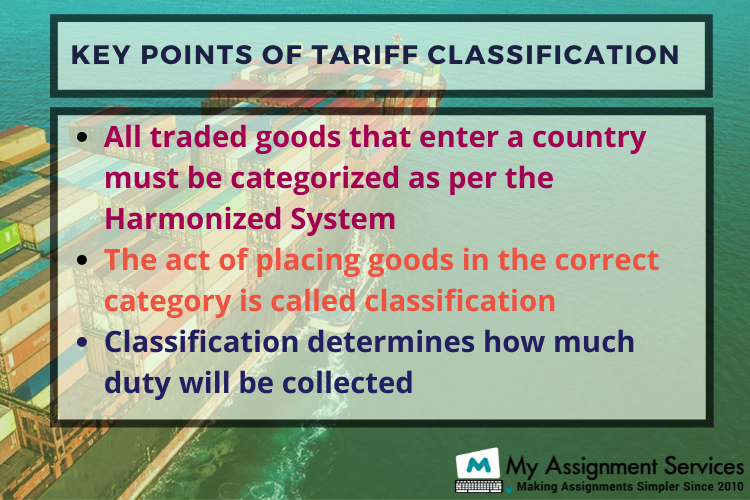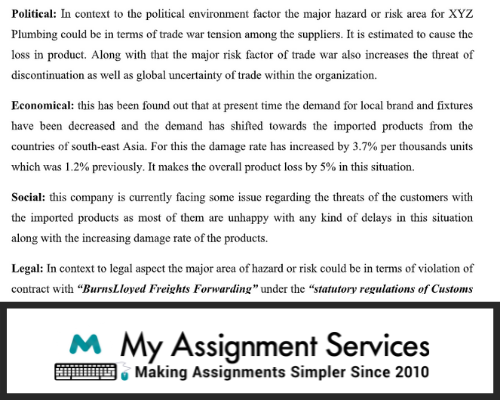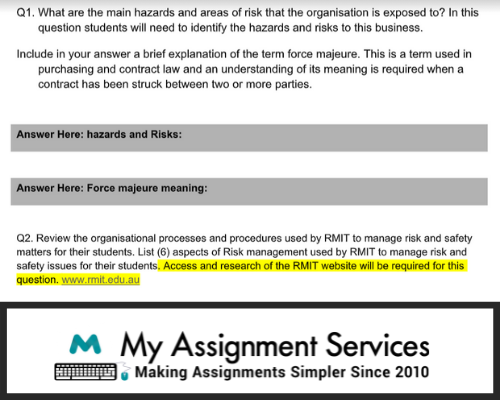Highlights
Tariff classification refers to the act of placing export and import commodities into sections. Each nation has a process for categorizing tariffs, and commodities that are imported. This is referred to as the Harmonized Tariff Schedule. The standard of categorization decided upon is significant as it explains the amount of duty gathered on the good. According to Australian Border Force, there are approximately eighteen schedules of the customs tariff act. Students are required to possess knowledge about these schedules to complete their assignments effectively and also within the deadline. Students have been relying on Tariff Classification Assignment Help for sailing successfully through the wide curriculum that Charles Sturt University offers. Are you looking for Tariff Classification Assignment Help to help you overcome all the challenges coming in your path to score top grades? If yes, do not panic! Experts at My Assignment Services are here to back you up and provide CUS105 Introduction to Tariff Classification. Our experts provide quality Charles Sturt University Assignment Help to students. Don't wait for the right time, place your order now and get quality assistance on tariff classification assignments.

Rulings of Tariff classification explain the Harmonized Tariff Schedule (HTS) facilities that are applied upon commodities that companies wish to import. These rulings are an extremely significant source for importers. How does one get tariff clarification and why are they so significant? This is the most frequently asked question to experts that provide Tariff Classification Assignment Help.
A tariff classification ruling is generally obtained from Customs and Border Protection (CBP) with the assistance of a Licensed Customs Broker. Several details are needed to process a binding ruling. Once finished, the ruling will explain the accurate needs that importers must follow. The ruling often also gives the accurate import duty that must be paid.
CUS105 Introduction to Tariff Classification is significant as it explains the amount of customs taxes and duties that an agency will pay for each transshipment. Goods are priced using a profit margin in mind which is explained by considering how much duty will be given on commodities. Tariff clarification is also based on various national and international regulations and laws. Software like e-Customs helps to transmit and sort via every tariff and explain which section it belongs to.
Online Assignment Help
Custom Essay Help
Dissertation Writing Service
A tariff classification ruling refers to an official notice given by the customs and border protection that determines which HTS code is applied to products being imported. The HTS code explains import duties and applicable import needs that their goods are required to stick to. When applying for a tariff classification ruling, CBP needs particular data regarding the goods including:
Failure to include any part of this information can result in the ruling request being delayed until the data is given.
In actuality, a tariff classification ruling is completely voluntary. Its objective is to clarify all related requirements and details about an import before it takes place. This also involves confirming the applicable import duties. Without retrieving a classification ruling, there is a chance that the transshipment may not be in compliance with needs and one might get hit with a significantly increasing import duty as compared to what is expected. An individual might think of the tariff classification ruling as administrative support for any agency wishing to import goods into the US. It lowers the possibility of non-compliance and enhances the possibility that the imported goods will arrive without unwanted delays.
As per our Charles Sturt University Assignment Help experts, tariff classification rulings can be useful in several conditions. Several nations have trading deals with the US permitting importers to pay lower duties and taxes and even none at all. Classification rulings explain whether any special duty rates apply or whether there are trade schemes that may benefit people. Very often, the nature of the ruling is based on the nations in which resource materials were harvested and the region in which several production steps are needed. Tariff classification rulings are also helpful for importers sourcing commodities from nations with trade agreements and programs with the US.
In several nations, customs regimes most importantly levy customs and import duties, administer licensing regulations, and anti-dumping roles entirely depending upon the HTS code in an import statement. In several customs authorities, a wrong HTS code declaration is considered a serious offense. HTS codes are required to be corrected to enjoy any FTA advantage that the trader emphasizes applying for. Traders must think regarding tariff codes as goods descriptions being transmitted into a set of numbers. Experts at My Assignment Services that provide Tariff Classification Assignment Help will help you understand the process of classification of products based on HTS code.
Tariff, which is the levy of ordinary custom duty, has witnessed a significant decline, to the objective of the WTO. Nonetheless, nations are having recourse to other techniques to save the domestic producers and they involve the application of non-tariff measures (NTMs), which gained power over time.
NTMs can be explained as those limited measures imposed to prevent foreign products from being imported into the nation. Unlike tariffs, NTMs are less transparent and they do not bring any rescue. It is a manner in which an economy controls its trading practices with other nations. Few instances of NTMs are voluntary export restraints, quotas, labeling, and packaging needs amongst others.
24 X 7 Support
100+ Subjects Covered
2000+ Ph.D Experts
Charles Sturt University facilitates the individual requirements of students and provides them opportunities for cumulative growth. The easy options that it gives students, in the context of programs and courses promote an impeccable sense of freedom in them. The tariff classification is a tailor-made course for students and busy professionals. It helps students to understand what classification is significant, new exporters or importers, on-boarding, awareness about ruling in exports and imports, and provide them a path to a new career. Tariff classification is a significant course in trading and students need to pay attention to its details. Hence, it is recommended to students seeking quality management assignment help which will provide them information about CUS105 Introduction to Tariff Classification. Here is a Tariff Classification Assignment Sample provided by our experts to help you make a quicker decision:

Below is a sample solution:

While our Charles Sturt University Assignment Help experts provide quality solutions at incredible rates, they also provide some exclusive features as mentioned below:
1,212,718Orders
4.9/5Rating
5,063Experts
Turnitin Report
$10.00Proofreading and Editing
$9.00Per PageConsultation with Expert
$35.00Per HourLive Session 1-on-1
$40.00Per 30 min.Quality Check
$25.00Total
FreeBonanza Offer
Get 40% Off *
on your assignment today
Doing your Assignment with our samples is simple, take Expert assistance to ensure HD Grades. Here you Go....